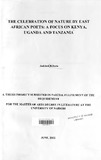The celebration of nature by East African poets: a focus on Kenya, Uganda and Tanzania

View/
Date
2012Author
Kibutu, Jedidah
Type
ThesisLanguage
en_USMetadata
Show full item recordAbstract
This study critically analyzes the manner in which nature has been celebrated by poets from East Africa; specifically, Kenya, Uganda and Tanzania. It is based on East African anthologies in English published between 1960 and 2012. The study sees a gap in the literary field where the East African poet's regard for nature remains largely unexamined. This is more so a propos associating this theme with the poetic style. In an endeavor to fill this gap, the study aspires to make a faithful representation of the place taken by nature poems in the East African literary canon.
The guiding hypotheses of this study are; one, that harmony of structure and content enhances a balanced analysis of nature poems. A second premise is that the theme of nature enhances a symbolic portrayal of human concerns. Lastly the thematic content of nature poems is seen as the reason for the specific graphic representation on paper. The study has adopted New Criticism and Deconstruction as the guiding analytic theories. The New Critical paradigm is applied, with close reading and a step-by-step analysis guided only by the text. New Critical tools are used to unlock the meaning of the poems, interlacing content and style.
Applying the theory of Deconstruction, a between-the-line assessment of the poem is made possible. The study sees a close connection between the East African nature poet and poets of the English Romantic movement. It therefore embarks on finding pivotal points which can be termed Romantic in some East African nature poetry, and pointing out any divergence therein.
The study concludes by showing thematic and stylistic findings and recommendations. The study uncovers features of nature which are the most popularly celebrated by the East African poets. It also states findings of the extent to which the East African celebration of nature fits the Romantic model. It also makes a recommendation regarding possibilities of future research.
Publisher
University of Nairobi, Kenya
